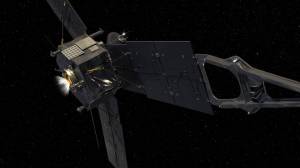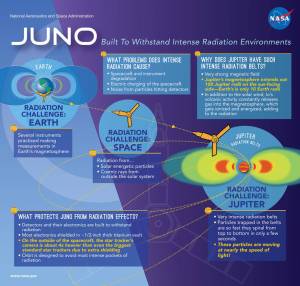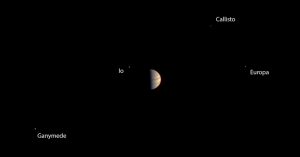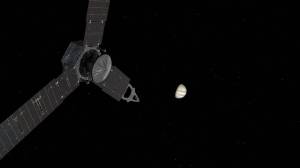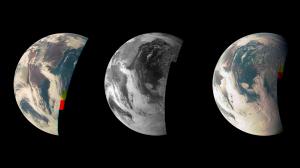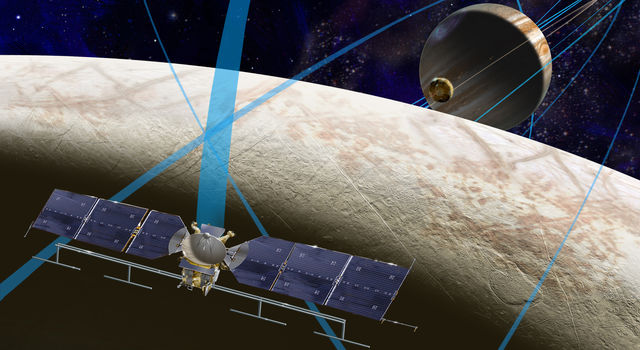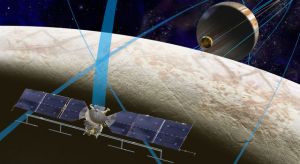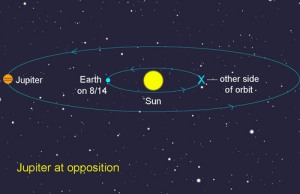Set to blast off sometime in the 2020s

The mission would place a spacecraft in orbit around Jupiter in order to perform a detailed investigation of the giant planet’s moon Europa — a world that shows strong evidence for an ocean of liquid water beneath its icy crust and which could host conditions favorable for life. The highly capable, radiation-tolerant spacecraft would enter into a long, looping orbit around Jupiter to perform repeated close flybys of Europa.
The concept image shows two large solar arrays extending from the sides of the spacecraft, to which the mission’s ice-penetrating radar antennas are attached. A saucer-shaped high-gain antenna is also side mounted, with a magnetometer boom placed next to it. On the forward end of the spacecraft (at left in this view) is a remote-sensing palette, which houses the rest of the science instrument payload.
The nominal mission would perform at least 45 flybys of Europa at altitudes varying from 1,700 miles to 16 miles (2,700 kilometers to 25 kilometers) above the surface.
This view takes artistic liberty with Jupiter’s position in the sky relative to Europa and the spacecraft. Credits: NASA/JPL/ESA
Space news (The search for life beyond Earth) – An artist’s rendition of the Europa spacecraft orbiting Jupiter –

Numerous linear features in the center of this mosaic and toward the poles may have formed in response to tides strong enough to fracture Europa’s icy surface. Some of these features extend for over 1,500 kilometers (900 miles). Darker regions near the equator on the eastern (right) and western (left) limb may be vast areas of chaotic terrain. Bright white spots near the western limb are the ejecta blankets of young impact craters.
North is to the top of the picture and the sun illuminates the surface from the left. The image, centered at 0 latitude and 10 longitude, covers an area approximately 2,500 by 3,000 kilometers. The finest details that can discerned in this picture are about 2 kilometers across (about 1,550 by 1,860 miles). The images were taken by Galileo’s camera when the spacecraft was 94,000 kilometers (58,000 miles) from Europa.
Image Credit: NASA/JPL/University of Arizona
NASA’s Jet Propulsion Laboratory released this artist‘s rendering of the Europa spacecraft, which is set to head to Jupiter sometime in the 2020s. The Europa Mission spacecraft configuration in early 2016 is shown in this image. The final spacecraft configuration at launch could easily be different, so stay tuned here for more news. The position of Jupiter in the sky relative to Europa and the spacecraft are also off in this drawing.

Image credit: NASA/ESA/K. Retherford/SWRI
Two large solar arrays are shown extending from the sides of the Europa spacecraft to which the ice-penetrating radar antennas are attached in this artist’s rendition. On the side of the craft, a saucer-shaped high gain antenna is depicted next to a magnetometer boom. On the forward section is a remote-sensing palette with the remaining science instruments.

Combined with the geologic data, the presence of a magnetic field leads scientists to believe an ocean is most likely present at Europa today. In this false color image, reddish-brown areas represent non-ice material resulting from geologic activity. White areas are rays of material ejected during the formation of the Pwyll impact crater. Icy plains are shown in blue tones to distinguish possibly coarse-grained ice (dark blue) from fine-grained ice (light blue). Long, dark lines are ridges and fractures in the crust, some of which are more than 1,850 miles long. These images were obtained by NASA’s Galileo spacecraft during Sept. 7, 1996, Dec. 1996 and Feb. 1997 at a distance of 417,489 miles.
Image Credit: NASA/JPL/University of Arizona
The Europa Mission profile has a very capable, radiation-resistant spacecraft traveling to Jupiter, where it enters into a long, looping orbit of the giant planet in order to perform at least 45 repeated flybys of Europa at altitudes ranging from 1700 miles to 16 miles (2700 kilometers to 25 kilometers) above its surface. Planetary scientists want to take a closer look at the evidence for an ocean of liquid water beneath its icy shell. An ocean of liquid water that could be the habitat of alien lifeforms we want to get to know better.
Learn more about NASA plans to handle a possible future asteroid impact on Earth around Sept. 20, 2020, of a body estimated at around 300 to 800 ft in diameter.
Learn more about NASA’s Europa Mission here.
Explore NASA’s Jet Propulsion Laboratory.
Learn more about Jupiter and its moons here.



